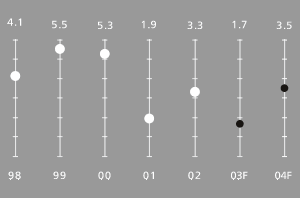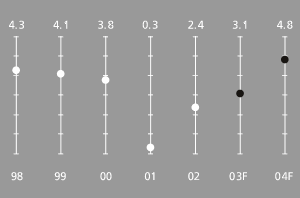
| What would you consider to be the greatest challenges facing the
Canadian financial services industry over the next few years?
The financial services sector in Canada is mature, concentrated and very competitive, with limited revenue growth opportunities for companies that do not find creative solutions for their clients’ unique needs. Competition from non-traditional and niche players has been a concern for some time. One avenue for growth is domestic consolidation. As the prospect for in-market mergers for the large players, such as the Big Five banks, is uncertain due to regulatory and political considerations that we hope will be resolved in 2004, a number of the Big Five banks have looked outside Canada for expansion. Overcoming the hurdles to in-market mergers, successful execution and integration of acquisitions and maintaining market share profitably on the home front are some of the challenges facing Canadian financial institutions. In addition, financial services
companies are continuing to look for opportunities to expand their
breadth and distribution of products and services and share of
their clients’ business
to sustain revenue growth. One challenge has been gaining regulatory
approval to offer insurance products directly to clients through
bank branches. We believe that allowing banks to sell insurance
through the branch network would enhance competition, and make
insurance products substantially more accessible and cost-effective
for Canadians. How will you improve the return on investment on the U.S. acquisitions made over the past few years? We are undertaking initiatives to improve sales and marketing effectiveness in our U.S. personal and commercial banking business by leveraging our Canadian capabilities and implementing Customer Relationship Management and client segmentation strategies. In addition, by opening new branches and offices in attractive, high-growth locations and making small, targeted acquisitions, we expect to further increase our returns. On the cost side, we are continuing to work to reduce costs by consolidating our technology platforms and integrating common head office functions and call centre operations across Canada and the U.S. Activities to improve our risk profile involve reducing the size of our commercial real estate portfolio and growing the size of our consumer loan portfolio. At RBC Mortgage, a subsidiary of RBC Centura, we are committed to improving our technology infrastructure and processes to enhance efficiency and returns. We have considerably reduced our fixed operating and infrastructure costs in our U.S. wealth management operations and will have significant operating leverage once capital market activity improves. In addition, we intend to enhance returns by continuing to move to a more holistic advisory approach instead of the traditional product-oriented transaction approach. The early gains are encouraging, with revenues from the top quarter of financial consultants who took the new wealth management business development course increasing an average of 24 per cent compared to a decline of 17 per cent for the firm’s average financial consultant. We also expect to increase our client base and assets under administration by expanding the branch office network, recruiting top financial consultants and making small opportunistic acquisitions of brokerage operations or assets. In our U.S. insurance operations, we also have both revenue and expense initiatives underway to improve returns. We announced in September 2003 our entrance into the relatively underserved U.S. travel insurance market, and we intend to gain a significant share of that business by leveraging our existing infrastructure and expertise. With the acquisition of Business Men’s Assurance Company of America, we now have the infrastructure to manufacture variable insurance products and have gained opportunities for sales through affiliated and independent broker- dealers. We are also continuing to bring greater efficiency by further integrating and centralizing our operational areas on a North American basis, eliminating geographic and operating silos. We are also developing our cross-sell and referral opportunities
between our U.S. businesses and on a North American basis to
enhance our revenue growth. We believe that these initiatives should
enable us to improve the performance of our U.S. acquisitions. What is your view of the increasingly competitive Canadian retail financial services market and the impact of pricing pressure on net interest margins? Competition in the retail banking market has intensified as several of our Canadian competitors have publicly committed to focusing on their retail operations, while reducing their corporate loan portfolios. The competition has resulted in erosion of net interest margins at some banks, as they have cut prices to maintain or increase their share of the market. Our strategy is to compete on advice and service, rather than on price alone. We realize that to attract and retain clients, we must offer a combination of excellent service, efficient processes and a range of products and services to match the needs of each client segment, all while being sensitive to providing good value to our clients. In that regard, we have accelerated our initiatives to deliver a superior client experience, adding that as our new strategic priority, which is discussed on pages 8 to 10. Since the beginning of 2003, we have seen our market shares
of mortgage, deposit and personal credit products in Canada
rise, reflecting significant success in client retention
and volume growth. Are you likely to acquire a large U.S. bank (say, US$2 billion+ in market value) over the next year or so? Although we have the capital capacity to undertake a larger acquisition,
there are none on the horizon at this time that meet our strategic,
cultural and financial criteria. We look for opportunities
that will provide a good cultural and strategic fit, and
have primarily focused on personal and commercial banking companies
in the Southeast U.S. In addition, we expect our acquisitions to
be accretive to our earnings within two to three years and to have
limited impact on our return on common equity ratio. As valuations
of most U.S. regional banks remained high and we are determined
not to compromise shareholder value, we made only very small acquisitions
in 2002 and 2003, largely to gain footholds in the high-growth
markets of Atlanta and Florida and use those as a base for organic
growth. Have you considered raising your dividend payout ratio to over 50 per cent as some global banks have done? At the end of 2002, we raised our dividend payout ratio goal from
30 to 40 per cent of earnings, to 35 to 45 per cent. In 2003, our
dividend payout ratio was 38 per cent. Increasing our
dividend payout is one of the ways we can reward our shareholders.
Reinvesting capital to grow our businesses organically and through
accretive acquisitions is another. We believe that a combination
of reinvestment for profitable growth and
dividend payments, along with share repurchases when appropriate,
is the best strategy for providing long-term value to
our shareholders. What is your economic outlook for North America in 2004? A reduction in uncertainty, the fading imbalances of expansion in the 1990s and a favourable policy environment are expected to boost North American growth in 2004. However, a number of risks remain. Households, businesses and financial markets may have to contend with a ballooning government deficit in the U.S. along with further increases in the Canadian dollar relative to the U.S. dollar. At the time of this writing, the U.S. economy was set to finish 2003 on an upswing, carrying a fair degree of momentum heading into 2004. The investment overhang created in the late 1990s has been largely absorbed. Some pockets of excess capacity remain, but in most sectors it has been worked down to levels that will necessitate new investment. Consumer balance sheets have improved alongside increases in stock and house prices and will help sustain consumer spending. Auto and home sales are expected to slow next year but productivity gains, cost control and the depreciating U.S. dollar will keep profits growing. Favourable credit market conditions and rising profitability stack the odds in favour of further increases in U.S. business investment spending in 2004 following gains in 2003. The twin deficits in the U.S. current account and federal government balances will keep the U.S. dollar under pressure relative to most world currencies, including the Canadian dollar. Following its sharp climb in 2003, the Canadian dollar is expected to appreciate again in 2004, but at a more modest pace, finishing 2004 at roughly 80 U.S. cents. As such, the transition in Canada away from export-led growth towards more balanced growth between the domestic and export economies is expected to continue. The Bank of Canada reversed course and reduced interest rates in 2003 to foster this transition and to offset the impacts of SARS and mad cow disease. The modest rise of Canadian unemployment in 2003 comes after a remarkable year of job creation in 2002 and poses less of a risk to the outlook than the slowly improving U.S. labour market. That market’s failure to convincingly recover since the end of the 2001 recession suggests long-acting structural changes in the economy may be at work. Such changes are often the result of technological innovations that can displace workers for extended periods. Should the U.S. job market falter, the momentum carried in 2004 could soften, jeopardizing the outlook for consumer spending. Thus monetary policy is expected to remain heavily titled towards growth in both countries with the U.S. Federal Reserve and the Bank of Canada not likely to raise rates until the second half of 2004. Low and stabilizing inflation will facilitate the task of monetary authorities, but a rapidly deteriorating U.S. federal government deficit could complicate matters for the Federal Reserve. Notwithstanding risks the U.S. economy is expected to expand by 4.8 per cent in 2004 after growing by an estimated 3.1 per cent in 2003. The Canadian economy is expected to grow by 3.5 per cent in 2004 after growing by an estimated 1.7 per cent in 2003.
|
| Canadian real GDP growth % change, year-over-year |
U.S. real GDP growth % change, year-over-year |
||
 |
 |
||
| F = Forecast in early December 2003 Source: Statistics Canada, RBC Financial Group |
F = Forecast in early December 2003 Source: Bureau of Economic Analysis, RBC Financial Group |